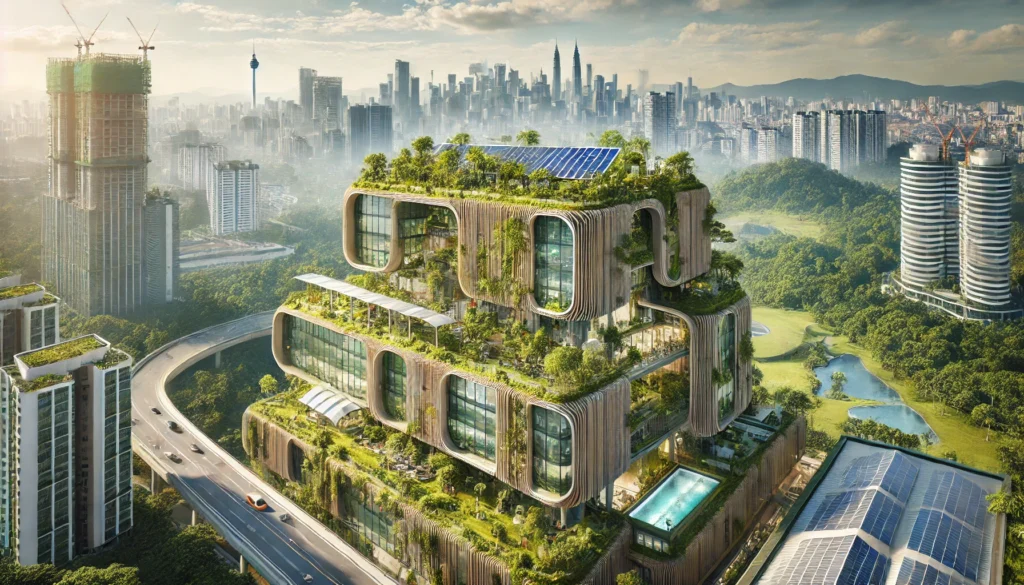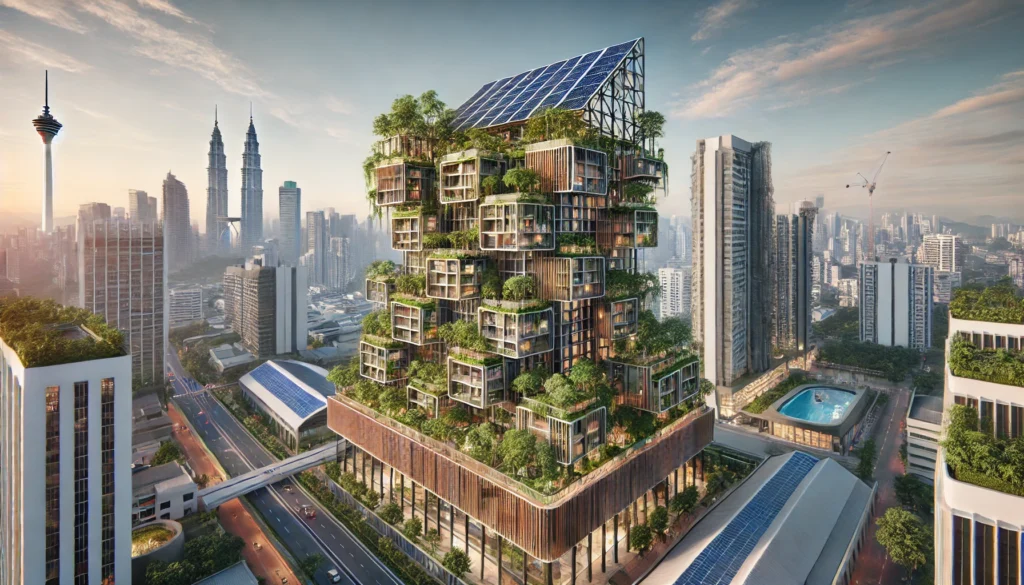The Malaysian government has recognized the importance of sustainable building practices in addressing both environmental concerns and urban development challenges. Several policies, incentives, and partnerships have been established to encourage the adoption of green building materials and energy-efficient technologies. Below, we explore some of the key initiatives and government programs aimed at fostering sustainable construction across the country.
1. Green Building Index (GBI) Incentives
The Green Building Index (GBI) is Malaysia’s flagship certification system for eco-friendly buildings. To further promote the adoption of GBI standards, the government has introduced financial incentives for developers and property owners who achieve GBI certification. Some of these incentives include tax exemptions and rebates, aimed at reducing the financial burden of building green.
2. Net Energy Metering (NEM)
The Net Energy Metering (NEM) scheme, introduced by Malaysia’s Energy Commission, allows buildings with solar panels to export excess electricity back to the grid. Under this scheme, buildings can offset their electricity costs by producing renewable energy and even generate revenue by selling the surplus back to the national grid. This has incentivized the installation of solar panels, especially in commercial and residential high-rise buildings.
3. Public-Private Partnerships
Malaysia’s move towards sustainable construction has seen increased collaboration between the government and private sector. Companies like Tenaga Nasional Berhad (TNB) and SP Setia have formed strategic partnerships to integrate smart energy and renewable energy solutions into new housing developments. These partnerships are crucial in bridging resource gaps and ensuring the wide-scale implementation of sustainable technologies in both urban and rural areas.
4. Government Grants and Financing
The Malaysian government, through agencies such as the Construction Industry Development Board (CIDB), offers various grants and financing schemes to support sustainable building initiatives. This includes funding for research and development in green construction materials and the provision of low-interest loans for projects that meet sustainability criteria (Construction Industry Development Board).
5. Sustainable Development Goals (SDGs) Compliance
Malaysia’s commitment to the United Nations’ Sustainable Development Goals (SDGs) has reinforced the nation’s focus on green building practices. Specifically, SDG 11, which focuses on sustainable cities and communities, has been a driving force behind the government’s push for the construction of environmentally responsible buildings. Projects that align with SDG criteria often receive additional support and recognition.
Challenges Facing the Adoption of Sustainable Materials in Malaysia
Despite the growing awareness and government incentives, several challenges remain when it comes to the widespread adoption of sustainable building materials in Malaysia. Below are some of the primary obstacles.
1. Higher Upfront Costs
While green building materials like bamboo, green concrete, and energy-efficient insulation offer long-term savings, they typically come with higher initial costs. The price difference between traditional and sustainable materials can be significant, making it difficult for developers with tight budgets to justify the switch. However, over time, the operational savings from lower energy and water consumption often offset the higher upfront investment.
2. Lack of Awareness
Many developers and contractors are still unfamiliar with the benefits of green building materials, especially in rural areas where traditional construction practices dominate. A lack of proper training and education also limits the adoption of innovative materials and technologies(Construction Industry Development Board).
3. Regulatory Challenges
Although voluntary certification systems like the GBI exist, Malaysia does not yet have mandatory green building regulations. This means that many developers still prioritize cost over sustainability unless they are incentivized through financial means. Establishing more stringent building codes that mandate the use of eco-friendly materials could help address this issue in the future.
4. Supply Chain Limitations
The availability of certain sustainable building materials, such as locally sourced bamboo and recycled steel, can be inconsistent due to supply chain limitations. This often leads to delays in construction projects or forces developers to import materials at higher costs.

Recommendations for Developers and Homeowners
Given the challenges and the evolving market for sustainable building materials, developers and homeowners can take the following steps to ensure that their projects are both cost-effective and environmentally responsible.
1. Invest in Lifecycle Cost Analysis (LCA)
Instead of focusing solely on upfront costs, developers should perform a lifecycle cost analysis (LCA) to evaluate the long-term savings of using sustainable materials. Materials like green concrete or energy-efficient windows may have higher initial costs but offer significant savings in energy and maintenance expenses over the building’s lifetime.
2. Partner with Certified Green Suppliers
By sourcing materials from certified green suppliers, developers can ensure that their projects meet both GBI and LEED certification standards. Working with recognized suppliers also helps streamline the supply chain and reduce the risks of material shortages(Construction Industry Development Board).
3. Utilize Government Incentives
Developers and homeowners should take full advantage of the incentives offered by the Malaysian government, such as the Net Energy Metering (NEM) scheme and GBI tax rebates. These programs can help offset the higher costs of implementing green technologies and materials.
4. Education and Training
To ensure long-term success in sustainable construction, both developers and contractors need access to proper education and training. Industry bodies like the CIDB offer courses and certifications in green construction techniques, which can help promote the wider adoption of sustainable materials.
Conclusion
The future of building materials in Malaysia is undeniably leaning towards sustainability, driven by government incentives, the need for energy-efficient buildings, and growing environmental awareness. The adoption of innovative materials like green concrete, bamboo, and recycled steel is helping Malaysia meet its Sustainable Development Goals (SDGs), while the GBI certification system provides a clear framework for green building projects.
As the country continues to urbanize, developers, architects, and homeowners must embrace these sustainable practices to reduce environmental impact and improve the quality of life for future generations. While challenges remain, particularly in terms of cost and supply chain limitations, Malaysia is making significant strides toward becoming a regional leader in green construction.
Frequently Asked Questions (FAQ)
What do you mean by sustainable construction?
Sustainable construction refers to building practices that prioritize environmental responsibility, resource efficiency, and minimizing waste throughout the lifecycle of a building. It aims to reduce the negative impact on the environment while enhancing the wellbeing of people using sustainable materials and energy-efficient designs.
What are the 7 principles of sustainable construction?
The 7 principles of sustainable construction include resource efficiency, reducing waste, using eco-friendly materials, maintaining biodiversity, conserving energy, protecting health and safety, and ensuring long-term viability in terms of durability and maintenance.
What are the 3 pillars of sustainability in construction?
The 3 pillars of sustainability in construction are environmental protection, social responsibility, and economic viability. These pillars ensure that construction projects meet today’s needs without compromising future resources.
How can a construction project be sustainable?
A construction project can be sustainable by incorporating energy-efficient designs, using renewable and recycled materials, minimizing waste, reducing carbon emissions, and ensuring that the building supports the health and wellbeing of occupants while having minimal impact on the environment.
What are the 5 pillars of sustainable development?
The 5 pillars of sustainable development are social inclusion, economic growth, environmental protection, good governance, and the preservation of cultural heritage. These pillars ensure that development balances growth with environmental and societal wellbeing.
What are the elements of sustainable construction?
Key elements of sustainable construction include the use of green materials, energy efficiency, water conservation, waste reduction, indoor environmental quality, and maintaining biodiversity in the surrounding area of the project.


